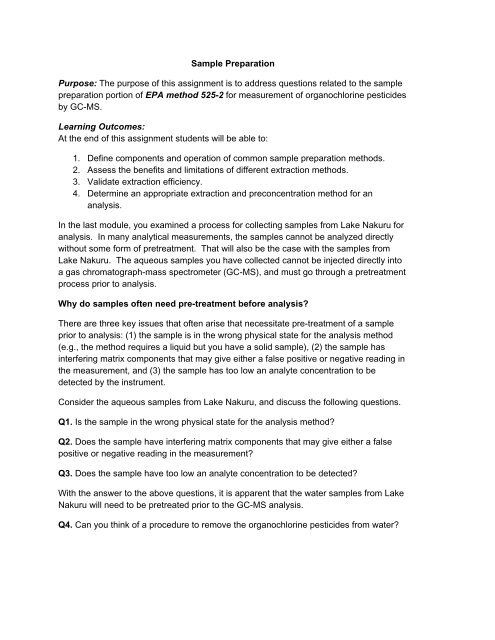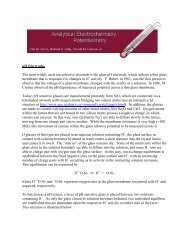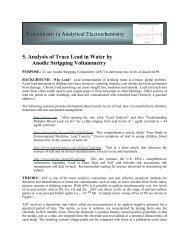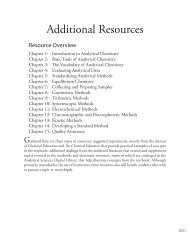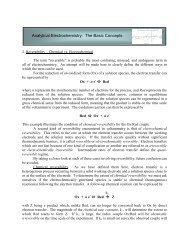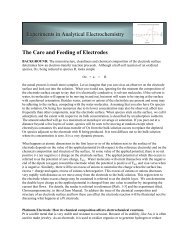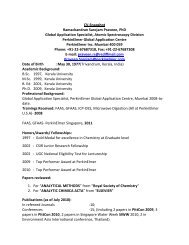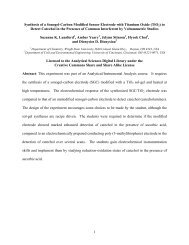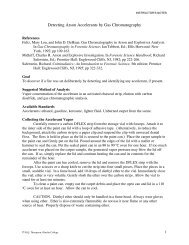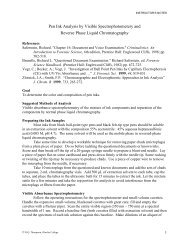Sample Preparation
Sample Preparation
Sample Preparation
You also want an ePaper? Increase the reach of your titles
YUMPU automatically turns print PDFs into web optimized ePapers that Google loves.
In other laboratories, for example in organic chemistry lab, you may have performed aliquid-liquid extraction to isolate a product or remove a contaminant. It is possible to usea liquid-liquid extraction with a water-immiscible organic solvent to removeorganochlorine pesticides from water. A more common form of sample pretreatmentused today involves a liquid-solid extraction. In this procedure, the liquid phase (in ourcase, the water sample) is passed through a cartridge or disk that is packed with a solidmaterial. The goal is to have the organochlorine pesticides adsorb to the surface of thesolid while the water passes through. You are probably familiar with water purificationfilters that can be attached to a tap to provide better drinking water. These operateunder the same principle as they are solid extraction cartridges that are designedremove components of the water that are not desirable to drink.Take a look at the following section (7.2) from the EPA procedure:“Liquid-Solid Extraction (LSE) Cartridges -- Cartridges are inert non-leachingplastic, for example polypropylene, or glass, and must not containplasticizers, such as phthalate esters or adipates, that leach into the ethylacetate and methylene chloride eluant. The cartridges are packed with about1 g of silica, or other inert inorganic support, whose surface is modified bychemically bonded octadecyl (C 18 ) groups. The packing must have a narrowsize distribution and must not leach organic compounds into the elutingsolvent. One liter of water should pass through the cartridge in about twohours with the assistance of a slight vacuum… The extraction disks containoctadecyl bonded silica uniformly enmeshed in an inert matrix. The disksused to generate the data in this method were 47 mm in diameter and 0.5mm in thickness. Other disk sizes are acceptable and larger disks may beused for special problems or when sample compositing is carried out. Aswith cartridges, the disks should not contain any organic compounds, eitherfrom the matrix or the bonded silica, which will leach into the ethyl acetateand methylene chloride eluant. One L of reagent water should pass througha disc in five to 20 min using a slight vacuum.”The procedure says that “one liter of water should pass through the cartridge in abouttwo hours with the assistance of a slight vacuum.”Q5. Why is this procedure done over two hours instead of 10 minutes?The procedure also specifies the use of an octadecyl cartridge.Q6. Why is octadecyl chosen as an extraction stationary phase for the study ofpesticides? What would happen if bare silica was used as an extraction phase?You now have the pesticides adsorbed onto the solid phase cartridge, but they are stillnot in a form suitable for analysis by GC-MS. The elution step involves the use of a liquidsolvent to desorb the organochlorine pesticides from the solid phase.
Q12. What does it mean to determine the precision of the pesticide analysis? Whatdoes it mean to determine the percent recovery of the pesticide?Q13. Suppose a solid-phase extraction procedure provided a low percent recovery.What could you change in an attempt to raise this value?The following table is real data obtained from the EPA method.Q14. Is the solid used in the cartridge effective for removing the pesticides from water?Q15. How is it possible to get a percent recovery of over 100?In addition to reconstitution, additional steps are often needed to preserve or preparesamples for analysis. The EPA Method 525.5 specifies that the water samples acquiredshould be specifically treated to preserve the pesticides:“8.2 <strong>Sample</strong> Dechlorination and Preservation -- All samples should beiced or refrigerated at 4 C and kept in the dark from the time of collectionuntil extraction. Residual chlorine should be reduced at the sampling siteby addition of 40-50 mg of sodium sulfite (this may be added as a solidwith stirring or shaking until dissolved) to each water sample. It is veryimportant that the sample be dechlorinated prior to adding acid to lowerthe pH of the sample. Adding sodium sulfite and HCl to the sample bottlesprior to shipping to the sampling site is not permitted. Hydrochloric acidshould be used at the sampling site to retard the microbiologicaldegradation of some analytes in water. The sample pH is adjusted to
samples cannot be held for 14 days but must be extracted immediatelyafter collection and preservation: carboxin, diazinon, disulfoton, disulfotonsulfoxide, fenamiphos, and terbufos. <strong>Sample</strong> extracts may be stored at 4 C for up to 30 days after sample extraction.”Q16. From the chemistry described in sections 8.2 and 8.3 of the EPA method, whatmight be the cause of pesticide degradation before extraction?Standards, Spikes and SurrogatesNote: A discussion of standards, spikes and surrogates will also be covered in themethod validation section. This section will highlight their roles in sample preparation.Take a look at the following excerpt from the EPA Method.“7.8 Fortification Solution of Internal Standards and Surrogates -- Prepare aninternal standard solution of acenaphthene-d 10 , phenanthrene-d 10 , andchrysene-d 12 , in methanol, ethyl acetate, or acetone at a concentration of 500µg/mL of each. This solution is used in the preparation of the calibrationsolutions. Dilute a portion of this solution by 10 to a concentration of 50µg/mL and use this solution to fortify the actual water samples (see Section11.1.3 and Section 11.2.3). Similarly, prepare both surrogate compoundsolutions (500 µg/mL for calibration, 50 µg/mL for fortification). Surrogatecompounds used in developing this method are 1,3-dimethyl-2-nitrobenzene,perylene-d 12 , and triphenylphosphate. Other surrogates, for examplepyrene-d 10 may be used in this solution as needed (a 100 µL aliquot of this50 µg/mL solution added to 1 L of water gives a concentration of 5 µg/L ofeach internal standard or surrogate). Store these solutions in an amber vial at4 C or less. These two solutions may be combined or made as a singlesolution.”Q17. What is a surrogate compound?Q18. What assumptions must be made when choosing a surrogate?Q19. When is the surrogate added during the sample preparation (i.e. before extractionor after) and why is it added then?Take a look at the following tables taken from the EPA Method 525.2.
Q20. What could be responsible for the different percentages of true concentration forthe surrogates in the two tables?Q21. What is an internal standard? Why is it used? At what point during the samplepreparation process are internal standards added?Q22. Why spike samples? Do you spike them before or after the sample preparation?Helpful Resourceshttp://www.sigmaaldrich.com/analytical-chromatography/samplepreparation/spe/reversedphase-methodology.htmlHarvey, D. Chapter 7, Collecting and Preparing <strong>Sample</strong>s.http://fs6.depauw.edu/~harvey/eText%20Project/pdf%20file/Chapter7.pdf


